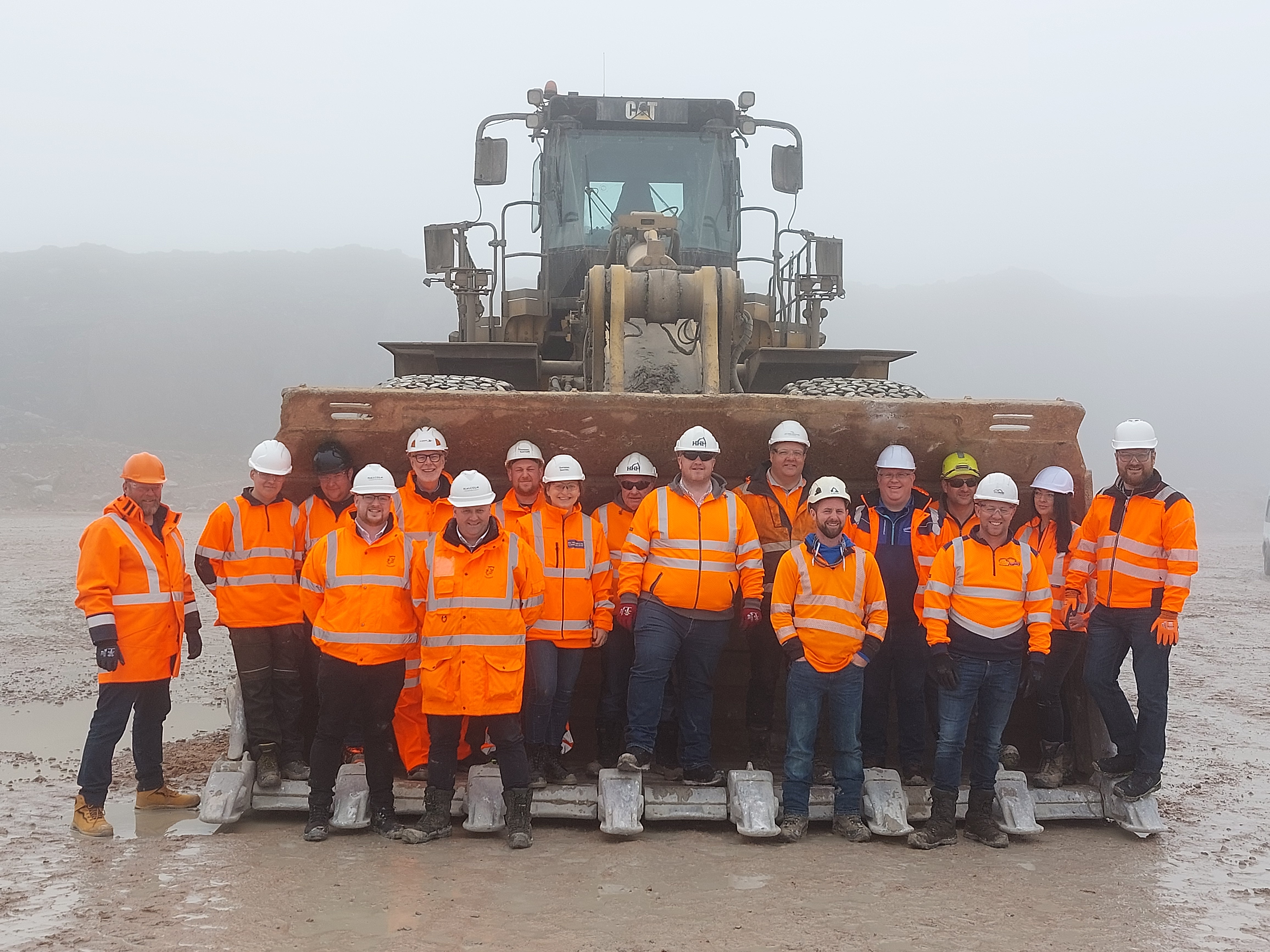Sub Menu
Glensanda - more than a quarry
Review of member visit by Callum Mackintosh
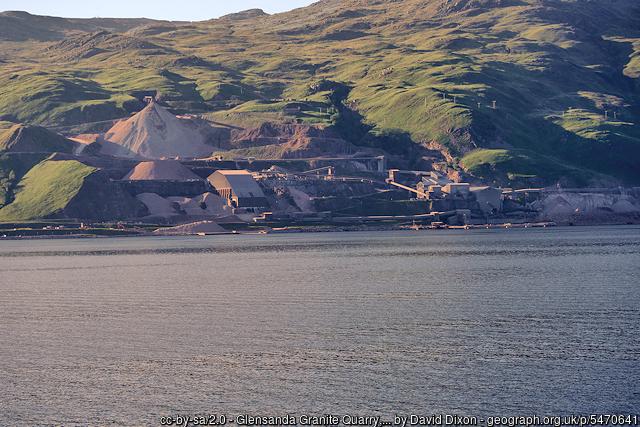
Imagine sailing up Loch Linnhe and looking up at the hills thinking “I could quarry that and export it all over the world”. Well, that’s what John Yeoman did, driven by the 1976 Verney Report. On the 5th August 1986, his vision became reality as Glensanda produced its first aggregate and loaded it onto the Hellesport Monarch. Ten days later the vessel arrived at its destination, delivering the quarry’s first export of 53,879 tonnes to Houston, Texas.
John Yeoman was a visionary and clearly not short of grit and determination. He took on the family’s Somerset-based quarrying business at the age of 21 following his father’s death and went on to turn it into a remarkable business becoming the envy of many other quarries across the country.
Inspired by this legacy, I’ve been aiming to host a members’ visit since I became President, it’s where some of the largest plant working in Scotland can be viewed on a scale that photos just do not do justice and is a visit which I’d hoped would inspire others. This is the story of our visit in May 2024 to Glensanda, which is more than just a quarry.
Remote Location
Located on the morvern peninsula and inaccessible by road, Glensanda is Aggregate Industries flagship site and the largest granite quarry in Europe.
To visit site, our twenty members and guests boarded one of the personnel vessels for the 35-minute ferry trip from the Rhugh Garbh depot in Argyll, just north of Oban. The sailing was a pleasure and is the sort of cruise that tourists flock to the west coast to pay a fortune for, I can imagine dolphins running alongside the boat in the summer and the views down Loch Linnhe are priceless, it’s an incredibly beautiful journey to work though undoubtedly less so in the winter.
The first thing that strikes you when arriving at Glensanda is the scale of the ship loading operation right along the port. Its vast, mountainous stockpiles are a site to behold behind the massive ship loader conveyor. But first we’re whisked away to the Steadings for breakfast and a morning briefing where we’ll learn about what work life is like here.
Life at the quarry
The staff make an impactful first impression, every individual is passionate about Glensanda, enthusiastic to share the stories of their work life and very open to all sorts of crazy questions.
Our visit coincided with our hosts work anniversary, 36 years to the day since Ian Henry joined Glensanda, he retires this month and has seen it all in his time there having come up through the ranks. We wish him all the very best in his retirement.
Around 200 on site jobs are supported by the super quarry, 65% of those are directly employed by Aggregate Industries with the remainder being subcontractors. Much of the workforce is local with AI having a strong ethos for investing locally both in people and community initiatives. For those traveling from further afield, an accommodation block with 60 rooms is onsite, this is comparable to a small hotel you’d find anywhere else in the country and is equipped with an excellent canteen, gym, lounge, pretty much everything you’d expect.
Everywhere in the quarry is clean, especially the buildings. Littering is non existent on site and the floors are so clean you could walk around in your socks. It’s a testament to the team for the respect they have for their surroundings and place of work.
For 363 days of the year the quarry works 24 hours a day, the only days it closes are Christmas day and New Years Day. Shifts are either 4&4 or 7&7 on and off, it’s a rotation which seems to work well here as although the work day is 12 hours, workers still need to endure 35mins of ferry each way plus transport up/down the hill to the quarry on top of the time it takes to commute to the Rhugh Garbh depot. A typical working day can therefore be 15 hours, so the shift patterns and rotation ensures a good work/life balance and mitigates fatigue.
Finishing our breakfast rolls and coffee which was hotter than the sun (presumably this is to keep you extra warm for visiting the top of the quarry) we boarded the transport and headed for the production area.
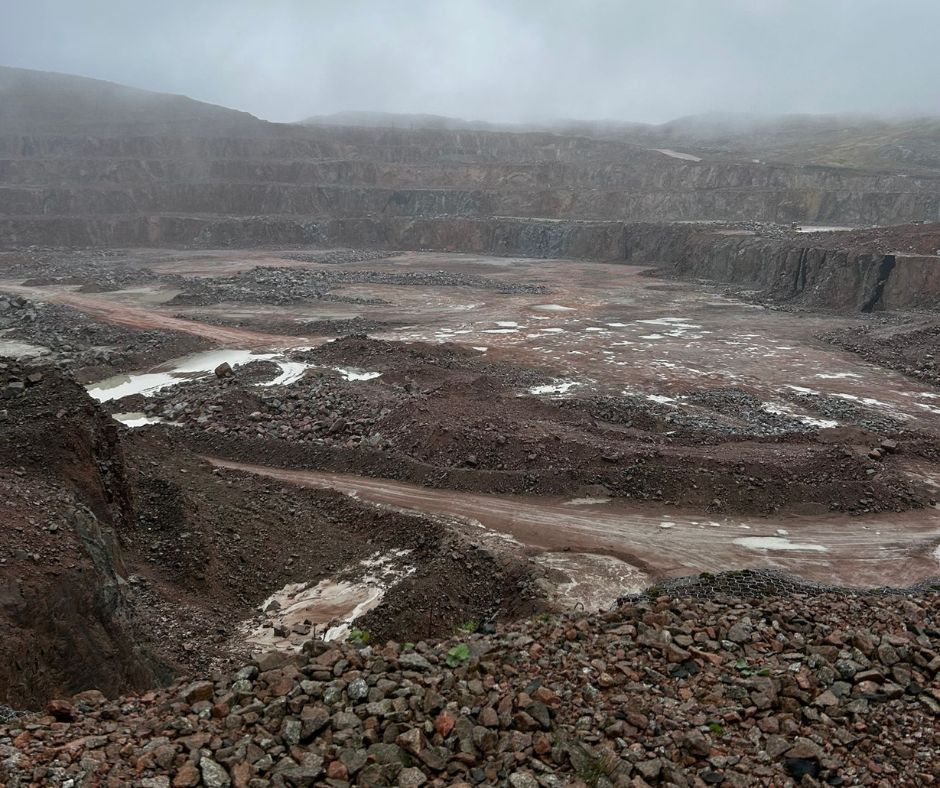
Production
Climbing the haul road up to the production area we passed various quarry development projects. A new series of finger lagoons were literally being started on the same day, these will allow silt to be pumped up the hill to settle rather than hauled and tipped as it is now in the lower silt store.
The haul road is in the process of being more than doubled in width, 100,000t has been blasted away to make space for a two lane haul road and segregated vehicle access road, this will increase production efficiency and safety especially when handling armour stone and delivering it to the armour stone jetty.
The Primary production site sits at 1600ft above sea level, so the operatives spend most of their life almost literally in the clouds with visibility being limited 75% of the time.
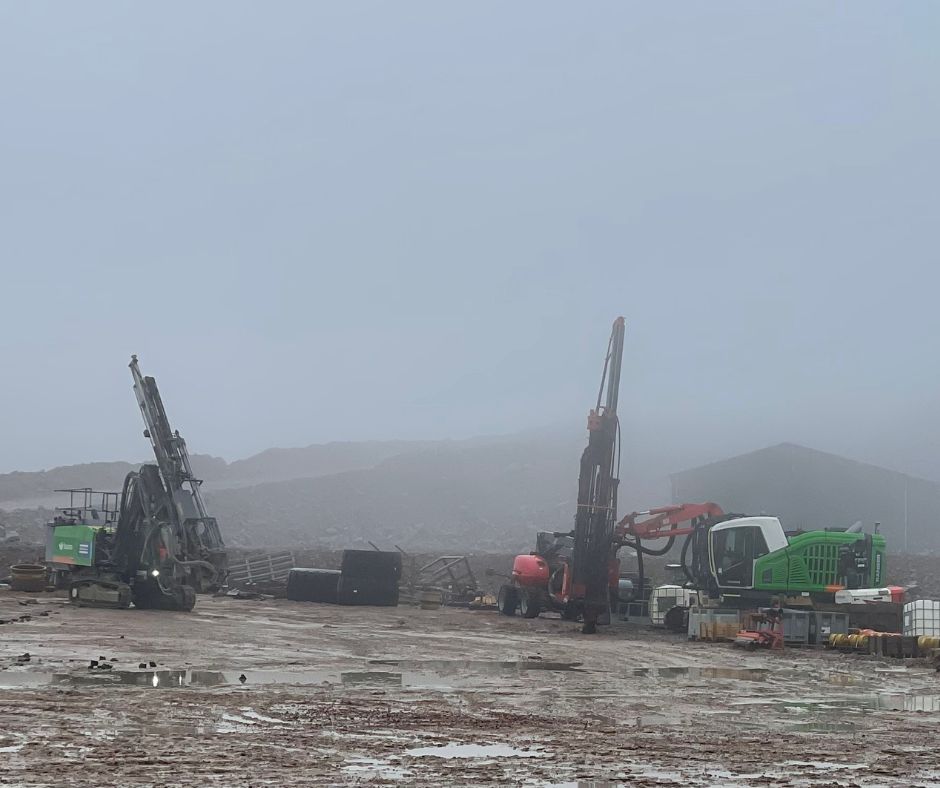 Drilling and Blasting is carried out by BAM Ritchies who are fulltime on the site. Blasts are conducted on average every two days, to achieve this Ritchies utilise five drill rigs, a mix of Sandvik Rangers and Epiroc Flexiroks. The site works 20m benches and drilling is done to a depth of 23m with a 127mm bit at 5m spacings, this brings the bench to a height and size which is safe and manageable to work on.
Drilling and Blasting is carried out by BAM Ritchies who are fulltime on the site. Blasts are conducted on average every two days, to achieve this Ritchies utilise five drill rigs, a mix of Sandvik Rangers and Epiroc Flexiroks. The site works 20m benches and drilling is done to a depth of 23m with a 127mm bit at 5m spacings, this brings the bench to a height and size which is safe and manageable to work on.
Each blast yields approximately 45,000 - 50,000 of material and is loaded into twelve 100t capacity CAT 777G rigid trucks by one of three CAT 992 shovels, part of a package of plant supplied by SPOA member Finning. This combination is 5 pass load matched to have the 777’s running with a payload of around 95t which was deemed optimal for the balance between production and uptime. The trucks could be pushed to haul a touch over 100t but repair and maintenance increases quite dramatically which voids any production gain.
Likewise, the 992s could move more as well. There are currently 2x 992K and 1x 992G all with 11m3 buckets. An increase in bucket could in theory bring the loading down to a 4 pass operation, the 992 would handle 25t-27t per bucket with ease and still stay firmly planted with all 4 wheels on the ground but the increase of stress on the loader arm is something to be avoided, it ensures uptime and has been calculated again to be the right choice long term to keep the cost per ton as low as possible.
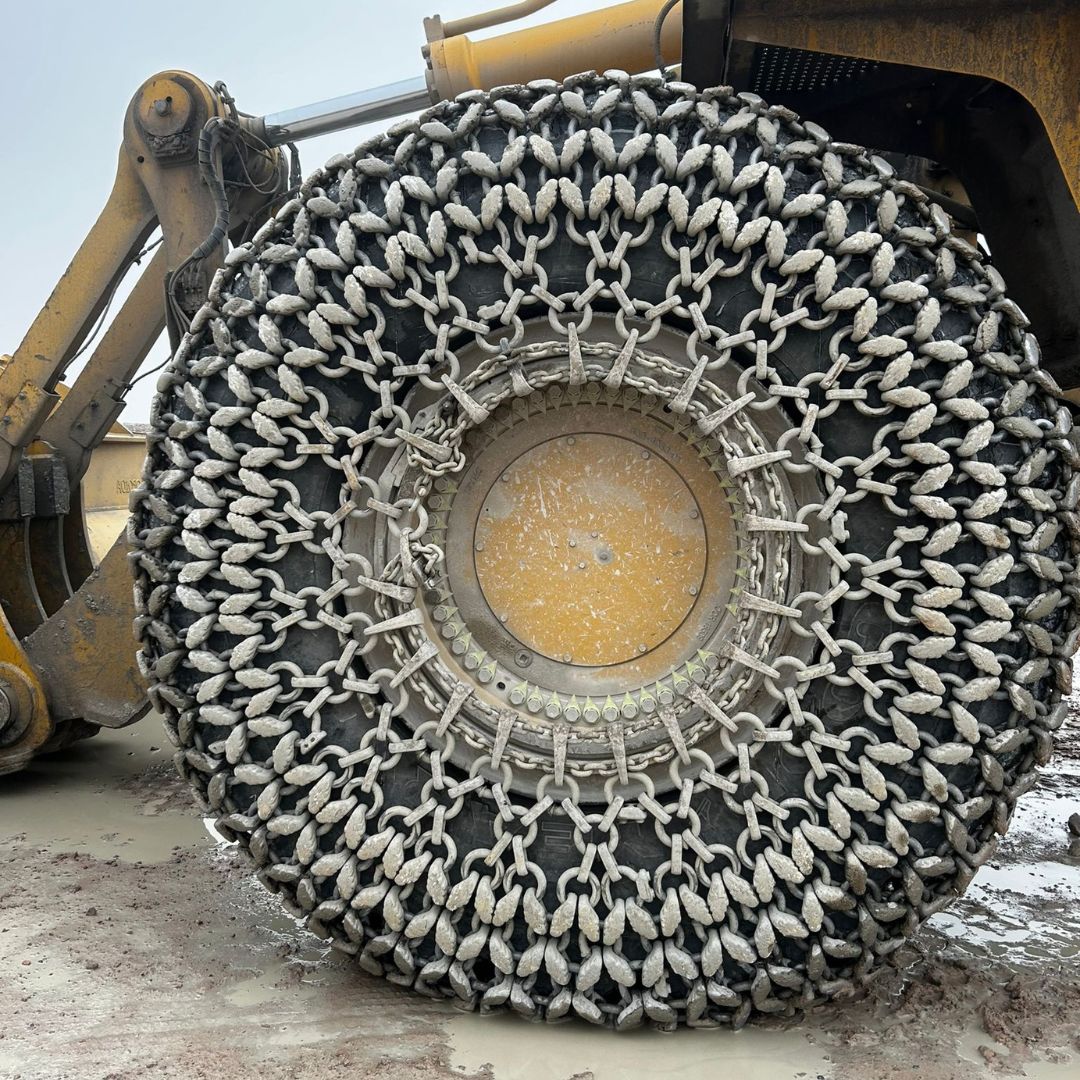
The 992s run chains on all four corners, it’s not really the done thing but this is yet another calculated call as the fragments on the benches are that sharp and the work are that tight, that risk of tyre damage is high. Glensanda chose to sacrifice a little fuel efficiency in place of uptime and reduced tyre cost. The tyre chains have done around 4500 hours, and the offside rear is now starting to show signs of wearing through due to the loading pattern. A pair of new chains have been ordered at £24,000 a piece, the nearside rear from one will be swapped onto the offside rear of another 992 to get the most of the older chains.
The wear package on the 777s features a 25mm Hardox450 liner which lasts around seven months, the welding team are starting to reline the skips on individual trucks now.
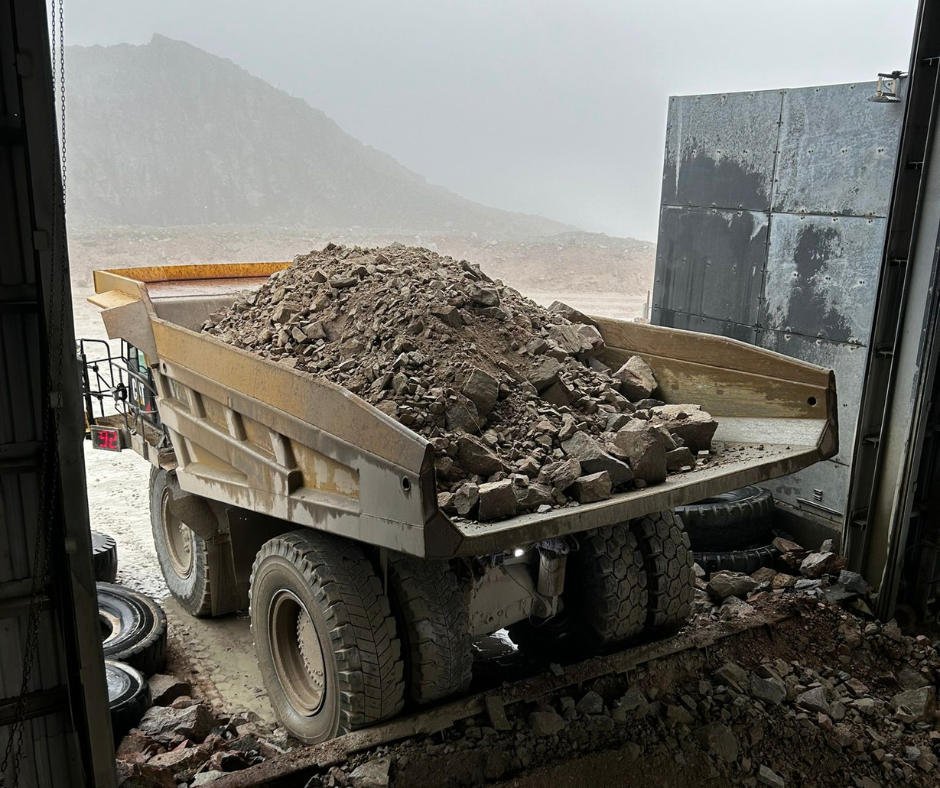
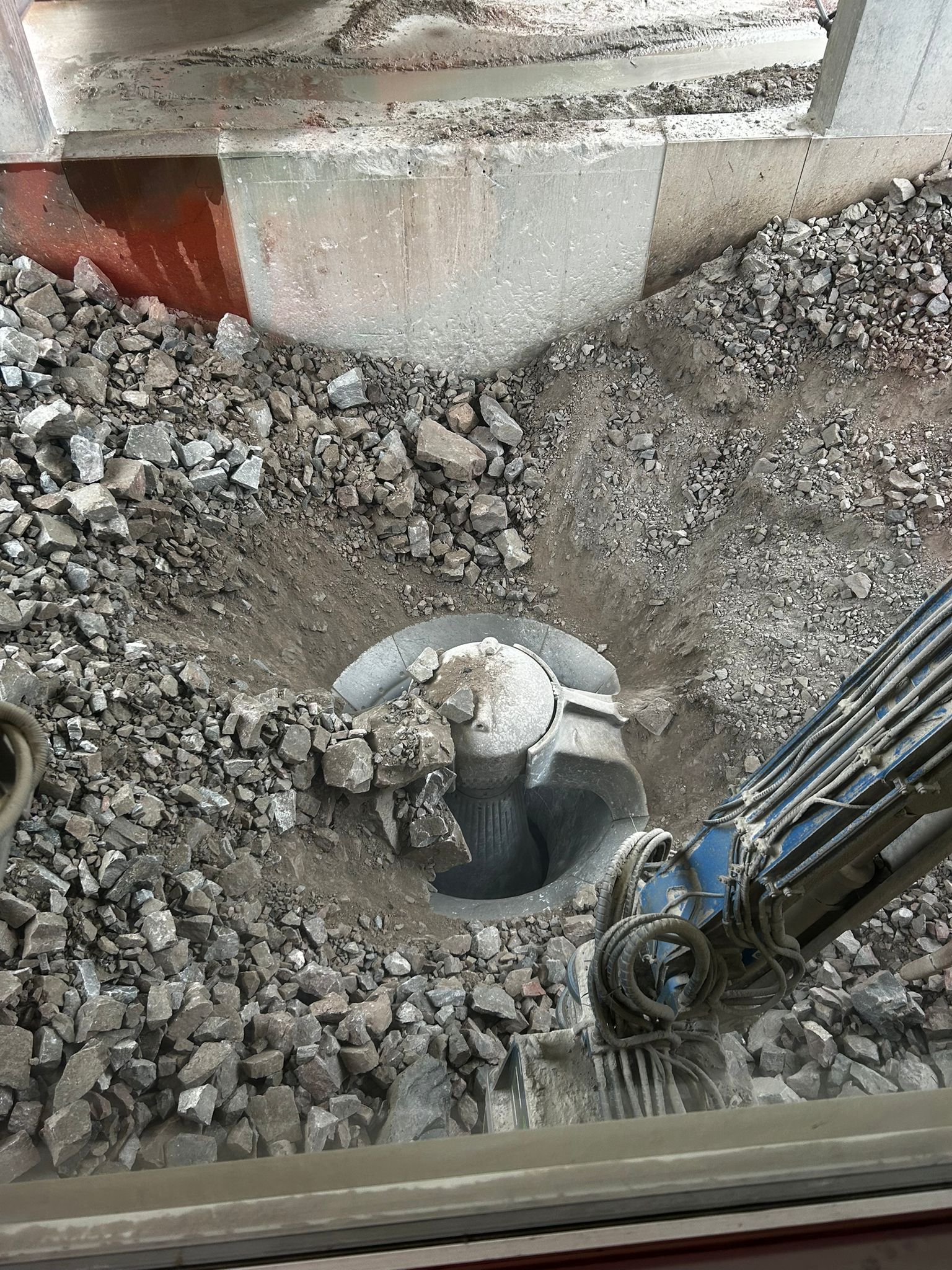 The crushing hall hosts the Metso gyratory crusher which can handle two 777s tipping simultaneously – one from each side. The crusher rarely gets blocked to the point it needs a breaker in to clear the blockage. The quarry manager stated it probably only happens twice a year on average. Instead, a CAT 336 long reach with a ripper attachment is on hand in the hall to ensure the material keeps flowing. This setup would benefit well from a CAT Command setup, remotely operating the long reach from inside the crusher operators office makes a lot of sense, and no doubt will be on the cards as a consideration.
The crushing hall hosts the Metso gyratory crusher which can handle two 777s tipping simultaneously – one from each side. The crusher rarely gets blocked to the point it needs a breaker in to clear the blockage. The quarry manager stated it probably only happens twice a year on average. Instead, a CAT 336 long reach with a ripper attachment is on hand in the hall to ensure the material keeps flowing. This setup would benefit well from a CAT Command setup, remotely operating the long reach from inside the crusher operators office makes a lot of sense, and no doubt will be on the cards as a consideration.
Glensanda's famous crushed pink granite is reduced to an 8”< product and flows down through the crusher onto a large stockpiling conveyor which discharges into a stockpile at the top of the 300m deep, 4m diameter gloryhole before travelling through 1.8km of conveyor tunnel to the secondary area.
The gloryhole method was first used in the UK at Glensanda, it’s a method which allows the quarry floor to be progressively lowered as the quarry expands. The current plan is to reduce the quarry floor a further 200m down.
Fuelling this fleet is no light task, the primary operation consumes 45,000l of white diesel each week. The 992s being the hungriest piece of plant with the K’s burning 90 litres and the G burning 115 litres per hour respectively. Fuel is supplied by road tanker to Rhugh Garbh depot and transported across on Aggregate Industries’ barge. Once upon a time though the fuel was shipped from the Aggregate Industries’ site at the Isle of Grain, Kent and pumped out of the ship then bunkered. Today the site stores circa 500,000l of white diesel to cover all operations and a contingency for severe weather restricting deliveries. On site, fuel is distributed by an ex WH Malcolm Scania 8x2 tanker, refuelling is undertaken in the evening, not only best practice but most practical given the shift rotations.
Naturally, Glensanda is constantly evaluating methods to increase productivity and, to that end, reduce fuel consumption. After studying the machine telematics and looking at site improvement opportunities the team believe they can get the cycle time of a 777 down from 12 mins to eight minutes by reprofiling the haul road gradient and route. Beyond this the site is currently evaluating a fuel additive which is expected to improve fuel efficiency and reduce emissions, we’re excited to hear how that evaluation goes.
I did question whether the site had considered using HVO instead of diesel, unsurprisingly their opinion was aligned to the rest of the industry. With no financial incentive from the Government to use it and no fuel efficiency gain big enough to cover the added cost, it is a non-starter.
Armour Stone
Armour stone is handled by RFS, a subcontractor to Glensanda and a subsidiary business of Aggregate Industries. Large pieces are picked out at the face and set aside then transported to the quarry floor for checking and selection. A Hitachi ZX890 excavator does the sorting and loading of the stone, with smaller stone 300kg-5t loaded into Develon DA45 ADTs and transported down to the armour jetty as orders require. The largest stones sent out for armour have been around 25t, very few quarries in the world can produce, handle, load and deliver such a size of stone in this volume.
RFS also carries out the development work on site, any stripping operations, restoration works or projects like the finger lagoons. A telehandler on long term hire from a Suffolk based hirer was a surprise to see and I’d encourage our members and any local supplier to engage with RFS to promote the strength and virtues of our local, Scottish supply chain.
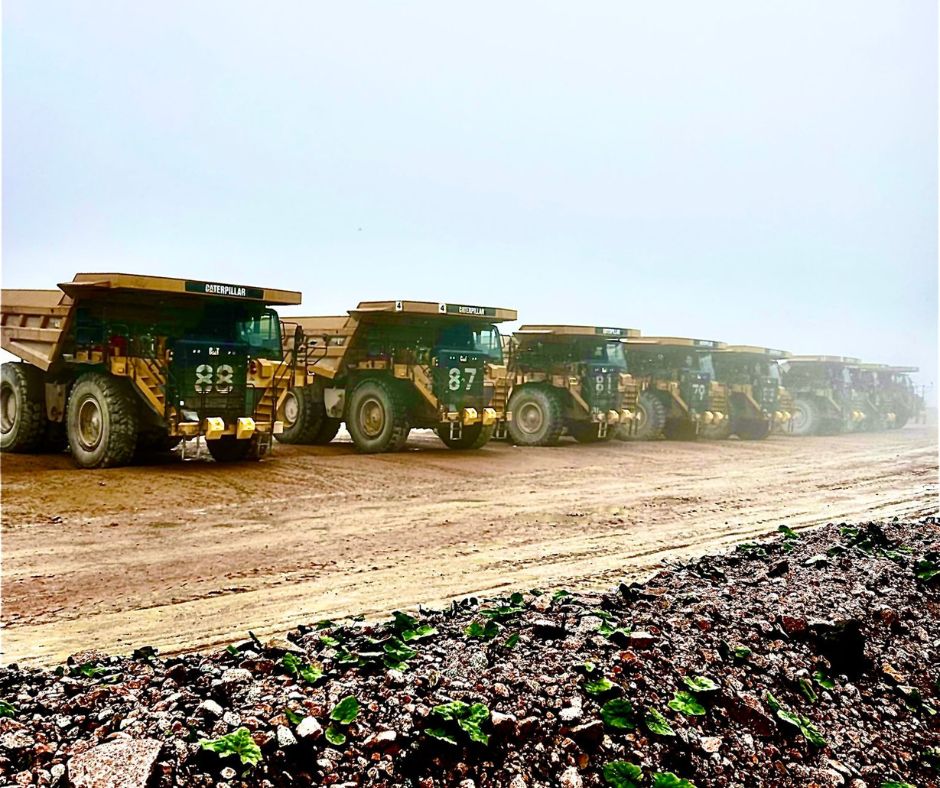
Site Fleet including Aggregate Industries and RFS
- 12x CAT 777
- 3x CAT 992
- 1x CAT 966
- 2x CAT D9
- 1x CAT 16 Grader
- 1x CAT 336 Long Reach
- 1x Hitachi ZX890
- 1x Hitachi ZX490
- 1x Develon DX480
- 6x Develon DA45
Workshop
Forward thinking is ingrained in everyone here, it’s a great legacy of Glensanda’s founder which has filtered through to everyone. Such thinking was on display in the impressive primary equipment workshop, the size of the building and its door openings have been designed to accommodate 150t class trucks like the CAT 785D or Komatsu HD1500 to scale up the operation in the future, whenever that may be required.
Equipped with four large workshop bays and a dedicated welding shop, the building can accommodate multiple machines at the one time. The eastern bay is dedicated to BAM Ritchies which carries out all of its drill servicing and repairs on site.
Over the workshop are two overhead cranes, one in the welding shop and one in the main workshop hall. The main crane has both 25t and 50t hook capacity and enough headroom to lift clear a 777 body off the truck chassis.
Extensive stores are held on site and managed digitally via a tablet system which each engineer uses with spares located on the mezzanine of the workshop area. Hydraulic hose assemblies are manufactured on site to OEM specification. Finning has supplied a CAT swager along with all the hose, fittings and specs for cut length and fitting orientation to ensure hoses are made accurately to fit first time. Fast moving hoses are manufactured on site and stocked on the shelf for additional speed of repair.
Wear parts are stocked here also. Teeth on the 992 loaders are replaced every three weeks roughly, the teeth used weigh around 50kg, and the overhead crane will be a blessing for this sort of work as that’s around 20 tonnes of teeth needed every year!
Secondary
From the 1.6km long conveyor exiting the gloryhole, the 8”< product is processed through a vast, sheltered, static secondary crushing and screening operation to produce a variety of products including:
These are:
- 32 / 75 Railway Ballast
- 2 / 16 Washed stone
- 0 / 4 CRF Granite
- 0 / 2 MP washed sand
- 0 / 32 Type 1
- Straight Base
- 2 / 22 DS
- 20 / 40 DS
These are then stockpiled on top of large feeder bins with discharging conveyors underneath which all connect to the ship loading system. Typically around 500,000t is kept stockpiled at any one time.
Ship loading and shipping
Every single product produced at Glensanda leaves here by sea and the site operates as a port in its own right. Stockpiled material can be loaded into the holds of vessels either as is or blended live on the ship loading system meaning the products listed above can be mixed to meet customer specifications. Specific blends are stored on the system and can be mixed and loaded at the press of a button.
The ship loader is capable of reaching every corner and hold of even the biggest ships without moving the ship on the berth. It loads at a rate of 6000t per hour with 90,000t often loaded in 22 to 24 hours. A product sample is taken off the belt frequently and sent to the onsite lab for testing and certification, this guarantees the quality and gives piece of mind that the customer will be satisfied with the product arriving seven days later.
Not all product is blended though, the rail ballast is found all over the south of England and certain markets prefer to take a straight crusher run for processing themselves at the point of delivery. This is common in Europe where Glensanda is supplying Holcim Group, the parent company of Aggregate Industries.
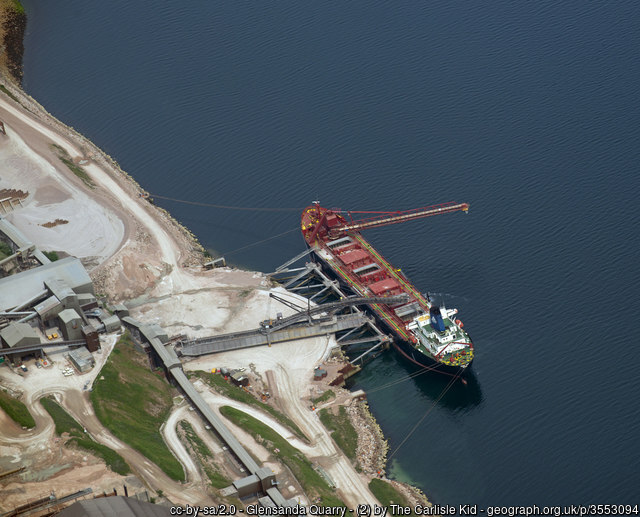 Aggregate Industries operates the largest self-discharging bulk carriers in the world, the Yeoman Bridge and the Yeoman Bontrup, both capable of carrying up to 100,000t!! These vessels are often loaded here to 85,000t rather than their maximum capacity, because despite being a deep water port, both vessels have a draft when loaded of 15.019m whilst the port has a berth depth of 12.3m plus the rise of the tide from 0.2m – 4.4m. Since an under hull clearance of 0.6m is required by the Harbour Master, it is a safer operation and assured departure from port if loaded to 85,000t or less.
Aggregate Industries operates the largest self-discharging bulk carriers in the world, the Yeoman Bridge and the Yeoman Bontrup, both capable of carrying up to 100,000t!! These vessels are often loaded here to 85,000t rather than their maximum capacity, because despite being a deep water port, both vessels have a draft when loaded of 15.019m whilst the port has a berth depth of 12.3m plus the rise of the tide from 0.2m – 4.4m. Since an under hull clearance of 0.6m is required by the Harbour Master, it is a safer operation and assured departure from port if loaded to 85,000t or less.
The current record tonnage loaded is 93,000t but as you can imagine, this took impeccable timing and matching to a specific high tide.
Discharging by these vessels can be done offshore or at quayside at a rate of up to 2,800tph depending on product. Since 1986, Glensanda has loaded around 2,600 ships. Today it loads around 150-200 vessels of varying size, annually with the total tonnage shipped to date sitting at 192 million tonnes and counting!
Markets
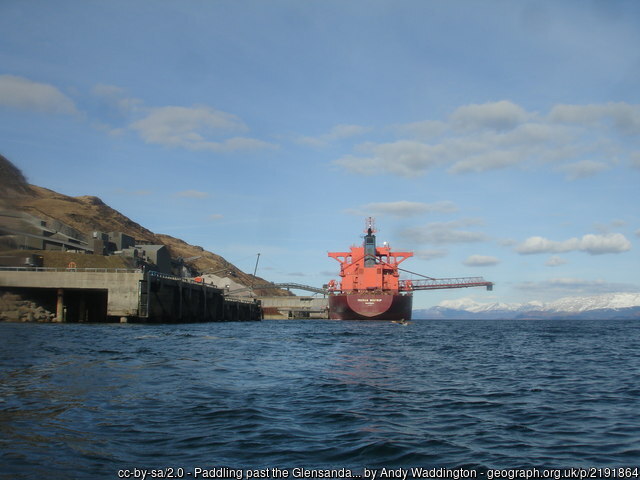 Glensanda ships to Aggregate Industries’ site at the Isle of Grain for supplying London with high spec aggregate as well as exporting to markets all across Europe and the rest of the world. Typically, all the sandy regions around France, Netherlands, Germany and Poland are regular destinations. Such are the economies of scale when producing 7.5m tonnes of aggregate and delivering it 90,000 tonnes at a time, it is said that Glensanda can deliver type 1 to these type of places for less than a truck can deliver it from a quarry in that country.
Glensanda ships to Aggregate Industries’ site at the Isle of Grain for supplying London with high spec aggregate as well as exporting to markets all across Europe and the rest of the world. Typically, all the sandy regions around France, Netherlands, Germany and Poland are regular destinations. Such are the economies of scale when producing 7.5m tonnes of aggregate and delivering it 90,000 tonnes at a time, it is said that Glensanda can deliver type 1 to these type of places for less than a truck can deliver it from a quarry in that country.
Future
With a global market and a futureproofed operation, the Glensanda super quarry has a bright future. The site is sitting on reserves of 900,000t which at current production should last until the year 2100.
I’d like to extend a huge thanks to the team at Aggregate Industries for facilitating this member visit and making our time at Glensanda a very enjoyable experience. If any members have suggestions for future site visit venues then please let us know. CM
